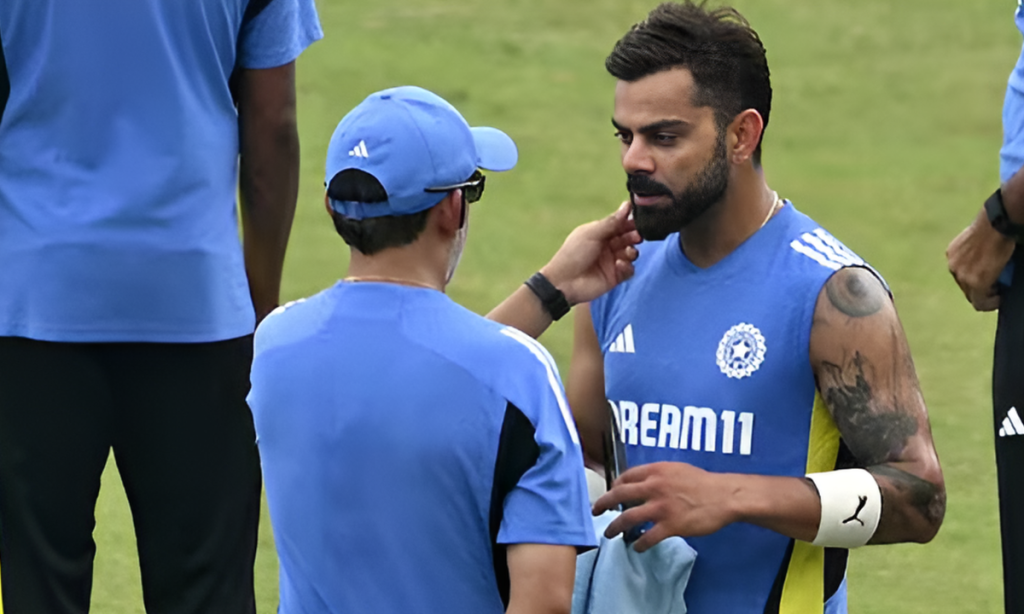Star India batter Virat Kohli began training with the Delhi team here on Tuesday ahead of his eagerly-awaited Ranji Trophy comeback after a 12-year gap.
The 36-year-old Kohli will be playing against Railways from January 30, marking his return to the premier domestic event where he last featured way back in 2012 in a game against Uttar Pradesh in Ghaziabad.
He arrived at the Arun Jaitley Stadium sharp at 9am this morning and after a team huddle and some warm-up exercises, proceeded to play football for about 15 minutes with his teammates.
All star players, including ODI and Test captain Rohit Sharma, have showed up for their Ranji teams after the disastrous Test tour of Australia recently.
This was owing to a BCCI diktat that players should prioritise domestic cricket whenever their international schedule allows them.
While Rohit (Mumbai) and Rishabh Pant (Delhi) did not have much success for their respective teams, veteran all-rounder Ravindra Jadeja starred with a 12-wicket haul for Saurashtra and Shubman Gill posted a hundred for Punjab, albeit in a losing cause.
Virat Kohli arrives for practice with Delhi team
Kohli was seen doing warm-up with the rest of the team at the Arun Jaitley stadium in Delhi. Prior to his arrival at the national capital, he was seen training with ex-India batting coach Sanjay Bangar.
Virat Kohli is here for net practice in Kotla.#RanjiTrophy #ViratKohli #Delhi @CricinfoHindi @ESPNcricinfo pic.twitter.com/er2hjj215H
— Daya sagar (@sagarqinare) January 28, 2025
He was reportedly working on his back foot shots as he aims to cut down on the outside off-stump trouble that plagued him in Australia.
Kohli’s return to domestic cricket comes at a time when his form in Test cricket has been under scrutiny. During the recent tour Down Under, Kohli struggled significantly, often getting out in similar fashion—caught behind or at slip while attempting to play away from his body.
This pattern of dismissals has not only been a concern for Kohli and his fans but also for the Indian cricket team’s strategy and future in the longest format of the game.
The decision to play in the Ranji Trophy can be seen as a strategic move to regain form and confidence.
Domestic cricket provides players with an opportunity to fine-tune their skills against varied bowling attacks, which might not be as skilled or strategically challenging as international bowlers but offer the familiarity and comfort of playing on home turf.
For Kohli, this return to where it all started is not just about cricket; it’s about reconnecting with his roots, understanding the game at a grassroots level, and perhaps rediscovering the joy of playing without the intense scrutiny of international cricket.
The practice session was a vibrant affair, with Kohli visibly enjoying the camaraderie with his teammates, many of whom are much younger and look up to him as an idol.
His presence was not just about preparing for the final league match but also about mentoring the next generation of cricketers from Delhi, a state that has produced numerous cricketing legends.
The session was intense, with Kohli focusing on footwork and shot selection, particularly against deliveries outside the off-stump.
He practiced extensively against pace as well as spin, indicating a well-rounded preparation for the upcoming match.
Observers noted a keen focus on his defensive technique, which has been criticized in recent times for being slightly less watertight than his peak years.
The anticipation around Kohli’s performance is palpable. Fans and critics alike are eager to see if he can translate his practice sessions into match situations.
His performance in the Ranji Trophy could be a significant indicator of his form going into the upcoming international assignments, providing both Kohli and the selectors with much-needed clarity on his readiness for the challenges ahead.
Moreover, Kohli’s participation in the Ranji Trophy sends a strong message about the importance of domestic cricket.
It underscores the ethos that every player, regardless of their stature, should contribute to the development of cricket at all levels.
This gesture could inspire many young cricketers not just in Delhi but across India, to value and engage in domestic cricket with the same intensity and dedication they reserve for international matches.
As Kohli steps onto the field against Railways, all eyes will be on him, not just to see if he can score runs but to observe if the ‘King’ can reclaim his throne in the cricketing world.
His journey back to domestic cricket might just be the narrative of redemption, resilience, and the undying love for the game that has defined his illustrious career.

